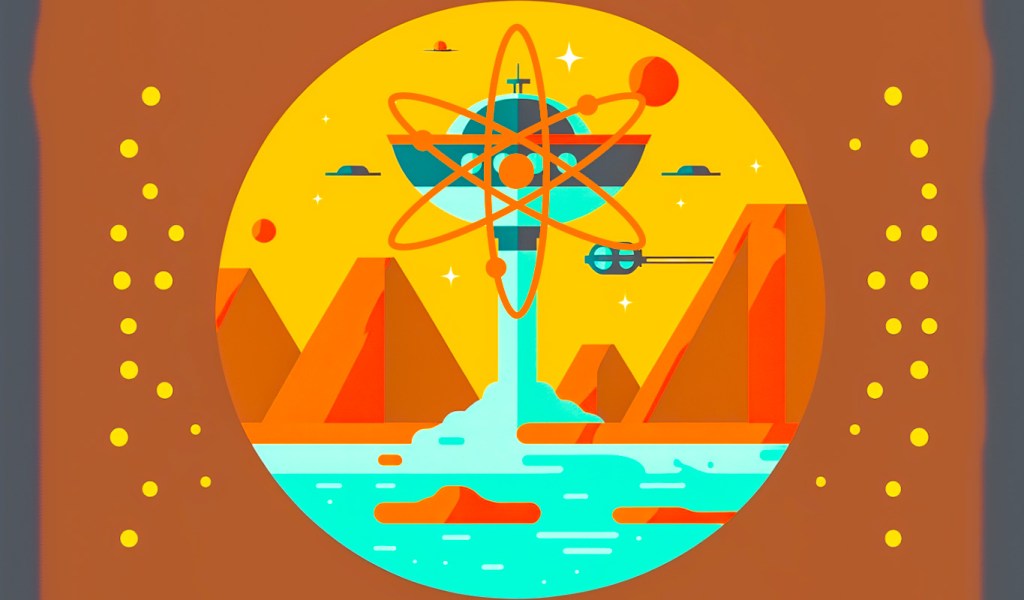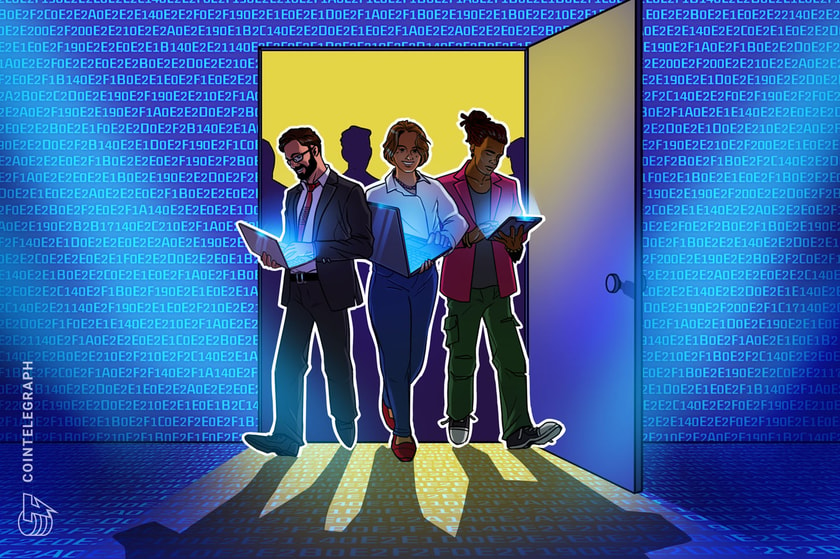
A crypto whale deposited more than $4 million worth of dYdX (DYDX) to the crypto exchange Kraken on Monday as the asset’s price pumped, according to the blockchain tracker Lookonchain. DYdX is a decentralized derivatives exchange. The project’s native token surged by 30% on Monday, the day the whale made the deposit. The whale would […]
The post Crypto Whale Deposits Over $4,000,000 Worth of DYDX to Kraken After 117% Rally in a Month appeared first on The Daily Hodl.

Venture capitalist Arthur Cheong says he’s “pretty bullish” on the Cosmos (ATOM) ecosystem amid recent developments. The DeFiance Capital founder and CEO says on the social media platform X that dYdX’s (DYDX) migration will increase the Cosmos ecosystem’s total value locked (TVL) and bring “huge amounts” of activity. TVL refers to the amount of capital […]
The post Veteran Crypto Investor Bullish on Cosmos (ATOM) Ecosystem Ahead of Potential $200,000,000 Tidal Wave appeared first on The Daily Hodl.

dYdX completes the launch of its layer 1 proof-of-stake blockchain with the creation of its genesis block by chain validators.
Decentralized cryptocurrency exchange dYdX has launched its layer 1 blockchain with the creation of its genesis block which will operate using native DYDX tokens.
The dYdX Chain is set to distribute all fees to validators and stakers in USD Coin (USDC). This includes trading fees denominated in USDC as well as gas fees for DYDX-denominated transactions or USDC-denominated transactions.
The proof-of-stake (PoS) blockchain network was built using Cosmos’ software development kit and makes use of CometBFT as its consensus protocol. Validators stake DYDX in order to secure the blockchain and carry out governance operations of the network.
The launch of the dYdX Chain network itself spanned a massive number of companies:
— Antonio | dYdX (@AntonioMJuliano) October 26, 2023
@dydx_ops_subdao coordinating genesis & launch generally + hosting indexer & frontend
@dydxfoundation coordinating community governance
@noble_xyz, @circleapp, @coinbase for launching…
Antonio Juliano, dYdX founder, highlighted that the launch of the dYdX Chain hinged on the likes of Circle and Coinbase launching on Cosmos in time for the creation of its genesis block. Juliano previously described dYdX as an "entirely new blockchain built on Cosmos SDK" and the "first-ever decentralized, offchain orderbook". The blockchain is also entirely open-source.
Before the launch of dYdX’s native layer 1 chain, the original DYDX was an ERC-20 token operating on dYdX’s original Ethereum layer 2 protocol. To facilitate the transition to its own layer 1 chain, the dYdX community voted to adopt DYDX as the L1 token of the dYdX Chain, adopt a one-way bridge from Ethereum to the dYdX Chain and to give wrapped Ethereum DYDX (wethDYDX) the same governance utility as ethDYDX in dYdX v3.
As a result of community votes and governance outcomes, the utility of the DYDX token has expanded to be used for staking, securing the network and assisting with governance on the dYdX Chain.
Similar to Ethereum’s transition to PoS, stakers and validators secure and protect the network and receive dYdX protocol feels in proportion to their staked assets. Fees collected by the dYdX Chain protocol are distributed to validators and stakers through the Cosmos distribution module.
An announcement from dYdX highlighted its expectation that the governance on the dYdX chain will be more accessible than its previous, Ethereum-based layer 2 protocol:
“The dYdX Chain does not have the dYdX v3 concept of ‘Proposing Power’; instead, the governance module effectively enables any holder to create a governance proposal with a deposit.”
Provisions to combat spam proposals include minimum deposit thresholds and voting mechanisms with veto powers. Users can only used staked DYDX tokens to participate in chain governance.
Chain validators will also inherit the voting weight of stakers, unless specific stakers opt to vote on proposals individually.
Magazine: Ethereum restaking: Blockchain innovation or dangerous house of cards?

The dYdX crypto exchange published the open-source code for its upcoming Cosmos-based network.
Crypto exchange dYdX has published the open source code for its new Cosmos-based network of the same name, according to an October 23 blog post. The new code includes the “protocol, order book, front-end, and more,” the post stated. The publication of the code is intended to pave the way for a mainnet launch, which is being organized by the dYdX Decentralized Autonomous Organization (dYdXDAO) SubDAO on Operations.
1/ It’s finally here
— dYdX (@dYdX) October 24, 2023
Today, we’re proud to present and fully open-source the completed dYdX Chain!
This is the next chapter for dYdX and we’re so excited that it’s here.
Let’s get into the details:https://t.co/ydil2jkqJs
DYdX is one of the largest non-custodial cryptocurrency exchanges, with over $2.6 billion in daily trading volume, according to Coingecko. However, it relies on a centralized order book to match traders with market makers. Because of this order book, it's sometimes regarded as not being truly decentralized.
The dYdX team has been trying to create a new Cosmos-based dYdX chain they say will allow them to decentralize the exchange’s order book, taking the protocol out of the hands of the development team and making it truly decentralized. They launched a testnet of the new network on July 5. DYdX currently runs on StarkEx, a layer-2 of Ethereum.
Related: Evmos, Swing, Tashi, Wormhole team up to solve Cosmos’ liquidity issues
According to the October 23 post, the new code will allow the dYdX infrastructure to “run globally by DeFi [decentralized finance] enthusiasts.” Once the mainnet launch is complete, the dYdX development team “will not run any part of the infrastructure behind any deployment of the new dYdX Chain.” The team did not state an official launch date for mainnet. Instead, it stated that readers should “check out the blog post from the dYdX Operations subDAO” to learn more.
In an October 4 post, the dYdX Operations subDAO proposed a phased mainnet launch. The proposed alpha phase will allow token holders to stake their tokens and earn staking rewards, but trading will not be possible. The beta phase will enable trading and allow further testing to occur. The post does not state a launch date for either phase.

An executive from digital assets investment firm Pantera Capital is predicting that GMX and one other decentralized exchange (DEX) altcoin will soon begin to outperform and steal value away from Uniswap (UNI). Portfolio manager Cosmo Jiang says in a thread on the social media platform X that decentralized perpetual trading platforms GMX and dYdX are […]
The post Pantera Capital Portfolio Manager Says GMX and One Additional DEX Coin Will Outperform Uniswap (UNI) appeared first on The Daily Hodl.

Crypto analytics platform Santiment says that three altcoins are showing signs of potentially reversing course after a bearish run. Santiment says that whale activity is on the rise for decentralized exchange protocol dYdX (DYDX), data exchange platform Ocean Protocol (OCEAN) and crypto payments network Request (REQ). According to Santiment, the rise in whale activity signals […]
The post Rising Whale Activity on These Three Ethereum-Based Altcoins a Sign of Potential Bullish Turnaround: Santiment appeared first on The Daily Hodl.

DYDX holders have voted to make the token the native asset for the new soon-to-be-launched dYdX Chain as the decentralized exchange (DEX) gears up to migrate from Ethereum (ETH) to its own network. According to snapshot data, the proposal, which was launched by crypto market maker Wintermute, concluded virtually 100% in favor of ‘Yes’ to […]
The post DYDX Token Slated To Be Native Asset for New Standalone Blockchain After Unanimous Vote appeared first on The Daily Hodl.

The founder of the decentralized exchange dYdX believes that crypto builders should focus on serving markets outside the United States for the next five to 10 years. Antonio Juliano tells his 49,400 followers on the social media platform X that the regulatory uncertainty in the United States is not worth the “hassle” or “compromises.” According […]
The post dYdX Founder Says Crypto Industry Should Give Up on US Customers As Market Not ‘Worth the Hassle’ appeared first on The Daily Hodl.

The founder of dYdZX argued that early-stage crypto projects can scale faster by ignoring U.S. customers, as they won't have to deal with the hassles of the U.S. regulatory climate.
Antonio Juliano, the founder of decentralized exchange dYdX thinks that crypto builders should forget about serving customers in the U.S. over the next five to 10 years, experiment in other markets and then return once the time is right.
In an Aug. 25 X (Twitter) thread, Juliano argued that builders should prioritize markets outside the U.S., as they will face fewer hurdles as they focus on platform growth and user adoption.
Juliano’s comments were particularly focused on startups as opposed to fully established platforms/businesses, as he emphasized that they could scale faster overseas in friendlier markets:
“Crypto builders should just give up serving US customers for now and try to re-enter in 5-10 years. It's not really worth the hassle/compromises. Most of the market is overseas anyways. Innovate there, find PMF [product market fit], then come back with more leverage.”
“In the grand scheme of things barely anyone uses or cares about crypto today. I personally don’t care about any outcome except growing crypto 100x+ long term,” he added.
Crypto is aligned with American values. What could be more American & capitalist than a financial system of the people, by the people, and for the people
— Antonio | dYdX (@AntonioMJuliano) August 25, 2023
That is literally what we’re building here. America will realize that eventually
Many in the industry have highlighted that the U.S. suffers from a lack of clear rules and regulations around crypto, with a key example of this being the gray area surrounding the jurisdiction of the Securities and Exchange Commission and Commodity Futures Trading Commission over the market.
As the U.S. government continues to drag its heels on establishing crypto regulation, Juliano suggested that the crypto sector needs to grow further so that it can have more sway on U.S. policy.
As such, he argues that it makes more sense in the meantime for builders or startups to focus on finding PMF overseas and then coming back with the “leverage” of large user bases.
“This does not mean crypto US policy work is not important. It absolutely is as it takes a really long time (must be ready for the re-entry) and much of the world will follow the US’s lead,” he said, adding that:
“Crypto not yet having world-scale usage/product market fit means we don’t yet have much influence in policy. We need to have products with massive usage where users (voters) say ‘wait, I need this’.”
Brian Armstrong, the CEO of Coinbase — a firm that has made several efforts to help drive crypto policy in the U.S. — responded to the post by offering a different point of view, as he noted that: “I see your point — but I think it will be better in a much shorter time. Probably by next year if I had to guess.”
Related: Does high US consumer debt benefit Bitcoin price?
“The U.S. always gets it right, after exhausting every other option. It will heal from these wounds, no matter how hard a small group of people try to stop progress,” Armstrong said.
I’m optimistic! And we’re helping our small part with policy too
— Antonio | dYdX (@AntonioMJuliano) August 25, 2023
I just think it’s different for startups vs scaled businesses. If you haven’t yet found strong product market fit the tradeoff to move faster & more freely seems worth the somewhat smaller market size
Wintermute CEO Evgeny Gaevoy also chimed in on the topic by agreeing with Juliano but stating that: “Only I think it will be either 2-3 years if crypto is successful or never if it is not.”
Magazine: Crypto regulation — Does SEC Chair Gary Gensler have the final say?

Discover five platforms — Aave, Compound, MakerDAO, dYdX and Fulcrum — that are transforming lending and borrowing through decentralization.
Peer-to-peer (P2P) lending, which links borrowers and investors directly, has become a well-liked substitute for traditional banking. P2P lending networks enable decentralized lending, in which people can borrow money from other people or institutions directly without the use of intermediaries, such as banks.

Both borrowers, who can receive loans with flexible terms, and investors, who can earn competitive returns on their investments, can profit from this lending arrangement. This article will look at five decentralized P2P lending services that let lenders and borrowers become involved in this expanding market.
Aave is a decentralized lending platform built on the Ethereum blockchain. By using digital assets like cryptocurrencies as collateral in smart contracts, it enables borrowers to receive loans. On the other hand, investors can lend borrowers their assets while still earning interest on their deposits.
Flash loans, which allow borrowers to obtain loans without providing collateral as long as the loan is repaid in the same transaction, are Aave’s distinguishing feature. This creates new opportunities for immediate liquidity and cutting-edge financial applications.
Compound is another decentralized lending platform operating on the Ethereum blockchain. It enables borrowers to place security and borrow items backed by the platform. Depending on the demand for particular assets, investors might lend their assets to borrowers and earn interest.
To ensure efficient capital allocation, Compound uses an algorithm that dynamically modifies interest rates based on the availability and demand of assets. By giving users the option to vote on suggestions for platform updates and parameter changes, the platform also lets users take part in governance.

The Ethereum blockchain-based decentralized lending platform MakerDAO is well-known for its Dai (DAI) stablecoin. By using their digital assets as collateral, borrowers can create DAI stablecoins, which are tied to the value of the United States dollar. Lending money to borrowers allows investors to receive interest in the form of stability fees.
Tokenholders who engage in voting on important choices, such as collateral kinds, stability fees and system upgrades, are a part of MakerDAO’s decentralized governance architecture.
Related: DAO governance models: A beginner’s guide
The decentralized derivatives trading platform dYdX also provides borrowing and lending features. Borrowers can trade on the site and borrow additional assets using their digital assets as collateral. Investors can lend borrowers their assets while earning interest on their deposits.
Users have freedom and leverage when trading thanks to dYdX’s lending and borrowing options. The platform, which supports various assets and marketplaces, runs on the Ethereum blockchain.
On the Ethereum blockchain, Fulcrum is a decentralized lending and margin trading platform powered by bZx. Investors can lend their assets and receive interest on their deposits, while borrowers can pledge their assets as security and obtain extra credit.
Related: Margin trading vs. futures: What are the differences?
Users can effectively manage their holdings thanks to the seamless integration of Fulcrum’s lending and trading services. Through the use of its native token, which enables users to vote on protocol updates and parameters, the platform also uses decentralized governance.